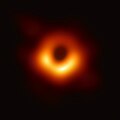Q star

A Q-star, also known as a grey hole, is a hypothetical type of compact, heavy neutron star with an exotic state of matter. Such a star can be smaller than the progenitor star's Schwarzschild radius and have a gravitational pull so strong that some light, but not all light, can escape.[1] Light going in the opposite direction of the star’s center would be the most likely to escape from it, while light going in a direction almost parallel to its surface is the most likely not to escape. The Q stands for a conserved particle number. A Q-star may be mistaken for a stellar black hole.[2] Some stellar black holes might be grey holes, two of which are V404 Cygni and Cygnus X-1. [1]
Types of Q-stars
[edit]- Q-ball[3]
- B-ball, stable Q-balls with a large baryon number B. They may exist in neutron stars that have absorbed Q-ball(s).[3]
See also
[edit]References
[edit]- ^ a b Brecher, K. (1993-05-01). "Gray Holes". American Astronomical Society Meeting Abstracts #182. 182: 55.07. Bibcode:1993AAS...182.5507B.
- ^ *Miller, J. C.; Shahbaz, T.; Nolan, L. A. (1998). "Are Q-stars a serious threat for stellar-mass black hole candidates?". Monthly Notices of the Royal Astronomical Society. 294 (2): L25 – L29. arXiv:astro-ph/9708065. Bibcode:1998MNRAS.294L..25M. doi:10.1046/j.1365-8711.1998.01384.x.
- ^ a b Kusenko, Alexander (2006). Properties and signatures of supersymmetric Q-balls. workshop on Exotic Physics with Neutrino Telescopes. Uppsala, Sweden. arXiv:hep-ph/0612159. Bibcode:2006hep.ph...12159K.
Further reading
[edit]- Abramowicz, M. A.; Kluźniak, W.; Lasota, J.-P. (2002). "No observational proof of the black-hole event-horizon". Astronomy & Astrophysics. 396 (3): L31 – L34. arXiv:astro-ph/0207270. Bibcode:2002A&A...396L..31A. doi:10.1051/0004-6361:20021645. S2CID 9771972.
